Introduction
Hey there, fellow adventure-seekers! Get ready for a wild ride as I take you on a journey through the world of rabbits in mythology.
So, hop on board as we explore the diverse tales and symbolism surrounding these enigmatic creatures.
Picture this: a mystical land filled with gods and goddesses, mischievous tricksters, and chilling encounters. In the heart of Japan, we stumble upon the captivating tale of the Rabbit of Inaba.
Prepare to be mesmerized as we look into the rabbit’s symbolism as a powerful symbol of rebirth in mythologies around the world. From the ancient Egyptians’ association with the goddess Hathor to the Chinese Zodiac cycle and its connection to good fortune, the rabbit’s influence knows no bounds.
Hold onto your hats, because the adventure doesn’t stop there! We’ll explore the rabbit’s mischievous side as the Trickster Rabbit in African folktales, where its cunning and cleverness make it an iconic figure.
And if that’s not enough to pique your interest, get ready for a deep dive into the mythological connection between the hare and the moon. From ancient beliefs to the tales of the Moon Rabbit in Chinese and Japanese folklore, we’ll explore the lunar allure that has captivated cultures across time and space.
So grab your adventure hat and prepare to be whisked away into a world of magic and wonder as we uncover the enchanting tales of rabbits in mythology. Whether you’re a believer in lucky charms or a skeptic ready for a experience, this article is sure to leave you captivated and craving for more.
Let’s hop to it!
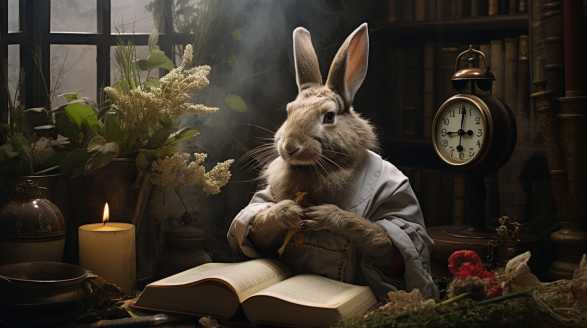
Key Takeaways
- Rabbits hold significant symbolism in mythology and folklore around the world.
- The Rabbit of Inaba is a popular Japanese folklore tale that showcases the rabbit’s cunningness and cleverness.
- Rabbits are powerful symbols of rebirth in various mythologies, such as ancient Egypt, China, and Native American tribes.
- The Trickster Rabbit plays mischievous roles in African folktales and Native American legends.
- Rabbits have a mythical connection with the moon in various cultures, including Chinese, Japanese, and Native American.
- In Aztec mythology, rabbits are associated with fertility and abundance.
- The Rabbit’s Foot is a talisman of good fortune, believed to bring luck, wealth, and protection against evil.
- The power of the rabbit’s foot lies in the belief and symbolism behind it.
The Rabbit of Inaba: A Japanese Folklore Tale
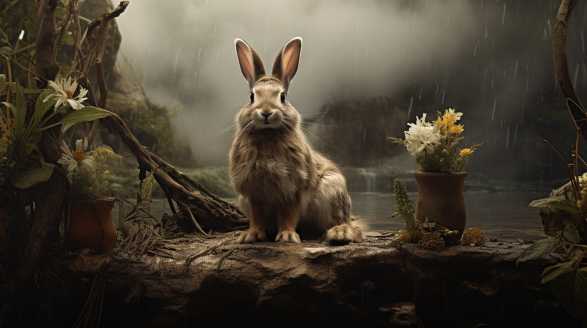
Have you ever heard of the Rabbit of Inaba? No?
Brace yourself for a whimsical tale filled with cunning animals, mischievous tricks, and unexpected alliances. Get ready to immerse yourself in the legend that has captivated the imaginations of generations.
Origins of the Tale
The Rabbit of Inaba is a popular folklore tale that originated in Japan. Passed down through generations, this enchanting story has become an integral part of Japanese culture.
Let’s dive into the origins of this captivating folklore.
Inaba, the Land of the Gods
Inaba, the setting of our tale, is a beautiful coastal region in Japan. It is believed to be a sacred land where gods and spirits reside.
The Rabbit’s Plight
One fine day, while strolling along the seashore, I stumbled across a peculiar sight. I noticed a rabbit, its fur gleaming white under the sun.
Little did I know, I was about to get entangled in a captivating fable.
The Mischievous Sharks
The Shark’s Challenge
As I approached the rabbit, it started to cautiously hop away. Intrigued, I followed it along the shoreline until I noticed a group of sharks swimming nearby.
The False Display of Loyalty
When the sharks saw me, they approached with a sinister smile plastered across their faces. They informed me that they had targeted the rabbit with an insidious game of deception.
The Rabbit’s Cunning Plan
The Rabbit’s Clever Question
Feeling perplexed, I listened carefully as the rabbit explained its plan. The rabbit knew of the sharks’ deceitful nature and devised a shrewd question to expose them.
The Sharks’ Fatal Mistake
Blinded by their own arrogant cunningness, the sharks fell into the rabbit’s trap. With a burst of confidence, they replied, “The last person who stepped on us was the noble King of Inaba!” Little did they know that their slip would seal their fate.
Divine Intervention
The Divine Monkey’s Aid
Suddenly, a divine monkey appeared from the heavens above. It had witnessed the rabbit’s ordeal and decided to lend a helping hand.
Okuninushi, the Wise Sage
Okuninushi, the wise sage, was known for his compassionate nature. He heard of the rabbit’s plight and immediately rushed to its aid.
The Rabbit’s Redemption
The Rabbit’s Fateful Transformation
Grateful for Okuninushi’s kindness, the rabbit decided it was time to repay the sage’s benevolence. It volunteered to be a messenger for the god of thunder, Takemikazuchi-no-kami.
The Tale Lives On
The Rabbit of Inaba’s heroic tale spread throughout the land, captivating the hearts and imaginations of many. Its unwavering courage and cleverness became a symbol of resilience and determination.
Cultural Significance
This captivating folklore tale holds immense cultural significance in Japan. It teaches valuable lessons about loyalty, cunningness, and the power of redemption.
As the story of the Rabbit of Inaba comes to a close, it leaves us with a renewed sense of wonder and appreciation for the magical world of Japanese folklore. This captivating tale takes us on an journey into the heart of Inaba, where cunningness triumphs over deceit, and divine intervention sets the stage for redemption.
The Rabbit as a Symbol of Rebirth: Mythological Perspectives
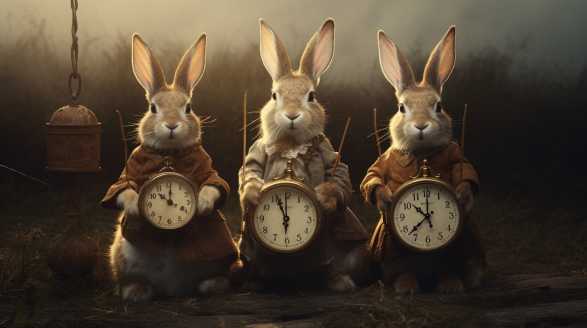
As I sit here pondering the notion of rebirth, my mind is drawn to the fascinating symbolism of the rabbit. This gentle creature has captivated the imaginations of various cultures throughout history, serving as a powerful symbol of rebirth and renewal.
The Rabbit in Ancient Egyptian Mythology
Divine Associations
In ancient Egypt, the rabbit was closely associated with the goddess Hathor, the deity of love, beauty, and fertility. The rabbit symbolized the concepts of rebirth and resurrection due to its exceptional reproductive abilities.
Lunar Connections
Another compelling aspect of the rabbit’s symbolism in ancient Egyptian culture is its association with the moon. The moon, with its cyclical phases, was often linked to fertility and rebirth in various mythologies.
This connection reinforced the rabbit’s symbolic representation of renewal and the ever-changing cycles of life.
The Rabbit in Chinese Mythology
Zodiac Sign
The Chinese zodiac cycle includes the Year of the Rabbit, which underscores the creature’s importance in Chinese mythology. People born under this sign are believed to possess qualities such as compassion, creativity, and an affinity for beauty.
Symbol of Good Fortune
In Chinese culture, the rabbit is also renowned for its association with good fortune. Legend has it that the moon goddess, Chang’e, had a rabbit residing with her in the moon.
This association with longevity and prosperity further solidifies the rabbit’s symbolic connection to rebirth.
The Rabbit in Native American Mythology
Trickster Archetype
Many Native American tribes regard the rabbit as a trickster figure in their folklore. Tricksters are mythical characters known for their ability to challenge conventions and bring about change.
This portrayal aligns with the idea of rebirth, as one must be open to change and new experiences in order to grow and evolve.
Creator of the World
Among the Cheyenne people of North America, the rabbit plays a significant role in the creation myth. According to their legend, the Great Spirit tasked the rabbit with the responsibility of shaping the world.
The Rabbit in European Folklore
Symbol of Easter
In Christian traditions, the rabbit has become synonymous with the celebration of Easter. This association can be traced back to the pre-Christian era when the rabbit symbolized fertility and rebirth during the spring season.
Magical Familiar
In European folklore, rabbits were also associated with witches and magic. It was believed that witches could shape-shift into rabbit form, allowing them to move swiftly and undetected.
As we conclude our exploration of the rabbit as a symbol of rebirth in various mythological perspectives, we are left in awe of the profound significance attributed to this gentle and prolific creature. From ancient Egypt to China, Native American cultures, and European folklore, the rabbit’s symbolism remains consistent in its representation of rebirth, renewal, and adaptability.
The Cunning Rabbit: Symbolism in Asian Mythology
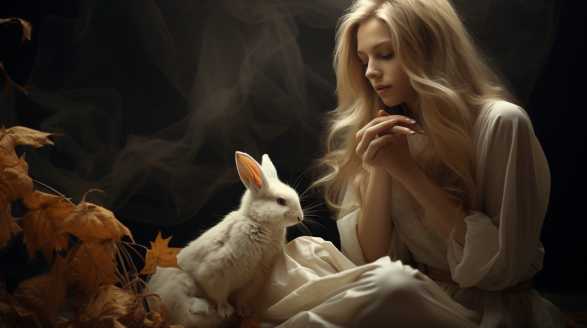
When it comes to mythology, there is an abundance of tales woven with symbolism and mystique. One fascinating figure that frequently appears across various Asian mythologies is the cunning rabbit. we will explore the profound symbolism behind the rabbit in Asian mythology.
The Bunny’s Quick Wit
Rabbits are often portrayed as clever and quick-witted creatures in Asian folklore. With their agile movements and keen senses, it is no wonder they have become a symbol of intelligence and cunning in numerous tales.
A Harbinger of Good Fortune
In Chinese Culture
In Chinese culture, the rabbit symbolizes good fortune and luck. This association dates back to the ancient Zhou Dynasty, where the Jade Rabbit was believed to live on the moon.
Even today, rabbit motifs can be found on Lunar New Year decorations, representing hopes for a prosperous year.
In Japanese Culture
Across the sea in Japan, the rabbit, or “usagi,” carries a similar symbolism of fortune. In Japanese folklore, there is a traditional belief that rabbits residing on the moon make mochi (a sticky rice cake).
This further highlights the positive associations of rabbits with good luck and abundance.
A Messenger of the Divine
Rabbits have also been connected to deities and the supernatural in Asian mythology.
In Vietnamese Folklore
Vietnamese mythology tells the tale of a magical rabbit, named Tướng Quân, who served as a loyal messenger for the Moon God, Chú Cuội. As a celestial being, the rabbit had the ability to travel between the mortal realm and the heavens, delivering important messages.
In Korean Tradition
In Korean folklore, rabbits possess the ability to communicate with the higher powers. It is believed that they can relay prayers and wishes to the heavens, acting as mediators between humans and deities.
The Rabbit’s Role as a Teacher
In addition to their association with fortune and divinity, rabbits are frequently cast as wise and instructive beings in Asian mythologies.
In Buddhist Stories
In Buddhist tales, the rabbit often takes on the role of a teacher, imparting valuable lessons to humans. One such story revolves around a rabbit who selflessly jumps into a fire, offering itself as a sacrifice to a wandering sage who tests the rabbit’s compassion.
In Indian Mythology
Within Indian mythology, the rabbit plays a central role in the story of the Bodhisattva, a being on the path to enlightenment. The Bodhisattva takes the form of a rabbit and is confronted by a beggar in disguise, seeking food.
This profound act of selflessness propels the Bodhisattva further along the path to enlightenment.
The cunning rabbit holds significant symbolism and plays multiple roles in the rich tapestry of Asian mythology. From being a harbinger of good fortune to a teacher of wisdom, this creature continues to captivate the imaginations of people throughout Asia.
If you ever come across a rabbit in Asian mythology, take a moment to appreciate the tales and teachings that it holds – for there is always more than meets the eye.
The Trickster Rabbit in African Folktales and Mythology
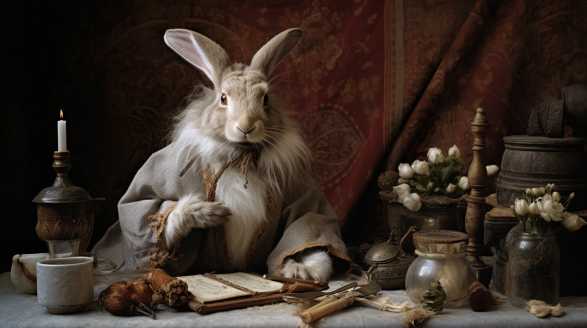
As a lover of folklore and mythology, I have always been captivated by the intriguing tales featuring the Trickster Rabbit in African cultures. This mischievous character has become an iconic figure, known for its cunning and cleverness.
Join me as we look into the enchanting world of the Trickster Rabbit, exploring the origins, characteristics, and fascinating stories surrounding this iconic archetype.
Origins: A Tale as Old as Time
The origins of the Trickster Rabbit can be traced back to ancient African civilizations, where storytellers weaved captivating narratives about anthropomorphic animals. This mythical creature, known for its cunning and trickery, surfaced in various African folklore and mythological traditions.
Though the stories may differ regionally, the Trickster Rabbit has maintained its mischievous nature across the vast African continent.
Characteristics of the Trickster Rabbit: Boundless Wit and Endless Charm
1. Cunning Intelligence
The Trickster Rabbit is renowned for its unmatched intelligence and quick thinking. Often outsmarting other animals and even humans, it relies on its wit to navigate challenging situations and escape tight spots.
2. Mischievous Nature
Mischievousness is the hallmark of the Trickster Rabbit’s character. It delights in playing pranks on others, exploiting their weaknesses, and reveling in the chaos that ensues.
3. Shape-Shifting Abilities
The Trickster Rabbit possesses the extraordinary ability to shape-shift, moving seamlessly between different forms. This transformative power allows it to adapt to any situation and manipulate its appearance to its advantage.
Tales of the Trickster Rabbit: A Kaleidoscope of Narratives
1. “How the Trickster Rabbit Outsmarted the Lion”
In this classic tale, the Trickster Rabbit finds itself in a predicament when confronted by a powerful and fierce Lion. Through a series of cunning tricks, the Rabbit manages to outfox the Lion, escaping unharmed.
2. “The Trickster Rabbit and the Magical Drum”
A captivating story from Central Africa, this tale depicts the Trickster Rabbit’s encounter with a magical drum that can grant any wish. The Rabbit’s cunning is put to the ultimate test as it tries to obtain the drum without falling into the traps set by the drum’s guardian.
3. “How the Trickster Rabbit Brought Laughter to the World”
Illustrating the Trickster Rabbit’s mischievous side, this story revolves around its quest to bring laughter to the world. Through a string of hilarious pranks played on animals and humans alike, the Rabbit spreads joy and mirth wherever it goes.
Cultural Significance: Lessons and Morals
The Trickster Rabbit, beyond its entertaining nature, holds deep cultural significance within African societies. Its tales serve not only as a form of amusement but also as a medium for imparting valuable life lessons and cultural knowledge.
The Trickster Rabbit’s adventures enable listeners to reflect on their own actions and navigate the complexities of life with ingenuity and resilience.
Enduring Legacy: The Trickster Rabbit in Modern Culture
The stories of the Trickster Rabbit have transcended time, remaining relevant and cherished in modern African culture. Its archetypal character has inspired numerous literary works, artworks, and even animated adaptations.
This enduring legacy serves as a testament to the Rabbit’s enduring charm and the universal appeal of its tales.
As we conclude our exploration of the Trickster Rabbit in African folktales and mythology, we are left with a profound admiration for this enigmatic character. Its wit, mischievousness, and shape-shifting abilities make it a captivating figure whose stories have stood the test of time.
So, let us embrace the spirit of the Trickster Rabbit and allow its stories to enthrall and inspire us as they have done for countless generations before us.
Rabbit Symbolism in Native American Myths and Legends
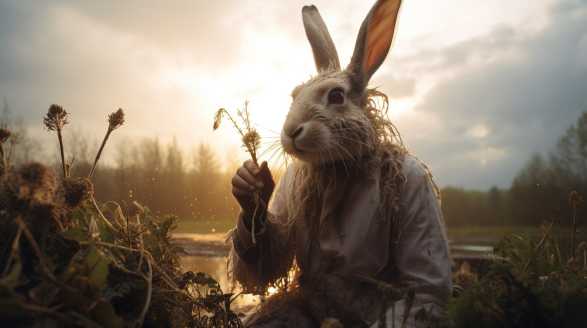
Ah, the rabbit! One of the most fascinating creatures in Native American myths and legends.
Join me on a journey into the world of rabbit symbolism, as we explore the rich tapestry of Native American folklore.
The Trickster Archetype: Rabbit as a Mischievous Figure
In various Native American cultures, the rabbit is often portrayed as a trickster figure. With its quickness and agility, it effortlessly plays pranks on other animals and even humans.
The rabbit’s cunning and cleverness are frequently celebrated in tales where it outwits larger, more powerful animals. Native American tribes believed that by embodying the rabbit’s sly nature, they too could gain an upper hand in their own lives.
Fertility and Abundance: The Rabbit’s Procreative Power
There’s more to the rabbit symbolism than just trickery. Many tribes saw the rabbit as a symbol of fertility and abundance.
The rabbit’s prodigious reproduction also symbolized the renewal of nature and the continuation of generations. Native American tribes often conducted dances and rituals depicting rabbits to invoke fertility and ensure prosperous seasons.
Balance and Harmony: Rabbit’s Connection to Nature
In Native American myths and legends, the rabbit often serves as a bridge between the natural and spiritual realms. It is believed that rabbits possess keen intuition, allowing them to sense the energies of the Earth and celestial bodies.
The rabbit’s connection to nature extends to its burrows. These underground dwellings represent a harmonious coexistence with the Earth and its elements.
Tribes and their Rabbit Legends
Hopi Tribe: The Great Rabbit and the Bear
The Hopi tribe from the Southwestern United States has a famous rabbit legend involving the Great Rabbit and the Bear. As the story goes, the Great Rabbit helps the Bear transform from a mischievous creature into a benevolent one.
The Great Rabbit outwits the Bear, teaching it valuable lessons about honesty and humility. This tale serves as a moral lesson for the Hopi people, emphasizing the importance of character and integrity.
Cherokee Tribe: Rabbit and the Moon
Among the Cherokee tribe, a renowned legend tells of the Rabbit’s role in shaping the Moon. In this tale, Rabbit and several other animals compete to reach the Moon and win its favor.
The Rabbit’s resourcefulness and ingenuity enable it to reach the Moon first. As a reward for its efforts, the Rabbit is granted an image of itself on the Moon, reminding the Cherokee people of the rabbit’s influential role in their lives.
Ojibwe Tribe: Nanabozho, the Rabbit Spirit
Nanabozho, the Rabbit Spirit, holds a central place in Ojibwe mythology. Nanabozho is known for his transformative abilities, as he can shape-shift into various forms, including that of a rabbit.
The Ojibwe people associate Nanabozho with the creation of the world and view him as a wise teacher. His presence embodies the rabbit’s characteristics of cunning, adaptability, and insightfulness.
Rabbit Symbolism in Modern Life
Even in modern times, the rabbit’s symbolism continues to inspire and captivate us. Its representation of fertility, agility, and instinctual wisdom resonates with many people seeking balance and harmony in their lives.
In popular culture, the rabbit’s symbolism often takes center stage in various forms of media, including literature, movies, and art. Its portrayal as a loveable trickster or a bringer of fortune showcases the enduring fascination with this creature.
Harnessing the Power of the Rabbit
So, how can we tap into the power of rabbit symbolism in our daily lives? Here are a few ideas:
- Embrace your mischievous side: As the trickster figure, the rabbit encourages us to be playful and quick-witted, using our cunning to navigate life’s obstacles.
- Seek fertility and abundance: Invoke the rabbit’s association with fertility and abundance through rituals or exercises focused on growth and prosperity.
- Connect with nature: Take a moment to appreciate the natural world around you. Feel a sense of unity with the Earth, just as the rabbit does.
- Learn from the past: Reflect on ancient legends and their teachings. Draw inspiration from the wisdom of Native American myths involving the rabbit.
The rabbit’s symbolism in Native American myths and legends is incredibly diverse and meaningful. From its mischievous trickster persona to its association with fertility and connection to nature, the rabbit continues to capture our imagination.
As we delve deeper into the rich tapestry of Native American folklore, it becomes clear that the rabbit holds a special place in the hearts and minds of countless tribes. So, let us embrace the rabbit’s cunning, learn from its stories, and embark on our own journey towards balance and harmony.
Hare and the Moon: The Mythical Connection
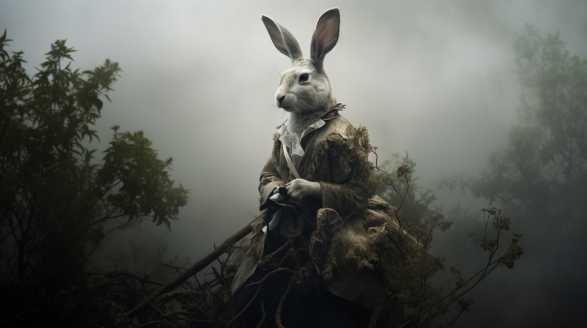
Growing up, I was always captivated by the tales of mythical creatures and their extraordinary adventures. One topic that has fascinated me for years is the connection between the hare and the moon.
Let’s look into this mesmerizing connection, exploring folklores, symbolic meanings, and intriguing mysteries associated with the hare and the moon.
The Hare in Folklore
Throughout history, the hare has been a prominent figure in folklore, often representing luck, fertility, and transformation. Many cultures believed that hares possessed supernatural powers and wisdom beyond our ordinary understanding.
In European folklore, hares were associated with the lunar goddess, often depicted as the “Moon Hare.” These lunar hares were believed to be shape-shifting creatures that could move freely between the mortal world and the realm of the divine.
The Moon’s Influence
The moon has long been a subject of fascination and wonder. Its ever-changing phases have mesmerized people for centuries.
In various cultures, the moon was seen as a guiding light, a celestial body that influenced the ebb and flow of life on Earth. It was believed to govern the tides, affect fertility, and even influence human emotions.
Lunar Hares: Guardians of Mysteries
The connection between the hare and the moon goes beyond their symbolic representations. Many cultures associated hares with the guardianship of moon-related mysteries and secrets.
In some ancient Egyptian myths, the hare was associated with the moon god Thoth, who was believed to be the deity of wisdom, writing, and magic. Thoth was often depicted with the head of a hare, symbolizing his connection to the lunar realm and the secrets it held.
Folklore Around the World
Across different cultures, the hare and the moon have been intertwined in countless myths and legends. Here are just a few examples:
- Chinese Folklore: In Chinese mythology, the Moon Hare is portrayed as the companion of the lunar goddess Chang’e. It is said that the hare grinds herbs on the moon, creating a magic elixir of immortality.
- Japanese Folklore: Japanese folklore tells the tale of the Moon Rabbit, who is believed to be a hare living on the moon. The Moon Rabbit is said to be pounding rice to create mochi, a traditional Japanese rice cake.
- Native American Folklore: Many Native American tribes have their own stories about the hare and the moon. In some legends, the hare is seen as a messenger between the moon and Earth, bringing wisdom and messages from the celestial realm.
Symbolic Meanings
The hare and the moon hold various symbolic meanings that have fascinated both ancient and modern civilizations. Here are some of the most prevalent interpretations associated with this mythical connection:
- Fertility and Growth: The hare’s associations with fertility and growth stem from its rapid reproductive abilities. In correlation with the moon’s cycles, it symbolizes the cyclical nature of life and the power of creation.
- Transformation and Rebirth: Just as the moon goes through phases, the hare embodies the concept of transformation and rebirth. It reminds us that change is a natural part of life, and with it comes the opportunity for personal growth and renewal.
- Intuition and Spirituality: The hare’s connection to the moon suggests a heightened sense of intuition and an affinity for the spiritual realm. It encourages us to tap into our inner wisdom and trust our instincts.
Mysteries Unsolved
Despite the rich folklore and symbolic meanings surrounding the hare and the moon, there are still unanswered questions and mysteries. Why have these two entities been intertwined for centuries?
The beauty of these myths is their ability to capture our imagination and leave us with a sense of wonder. They invite us to explore the unknown and embrace the mysteries that lie beyond our understanding.
The connection between the hare and the moon is a captivating tale that transcends cultures and spans centuries. It represents the power of the moon to inspire awe and provoke curiosity.
So, the next time you gaze up at the moon and catch a glimpse of a fleeting hare in the corner of your eye, remember the mythical connection that spans time and space. Embrace the mysteries of the hare and the moon, and let their enchantment ignite your imagination.
Rabbits in Aztec Mythology: The Connection to Fertility
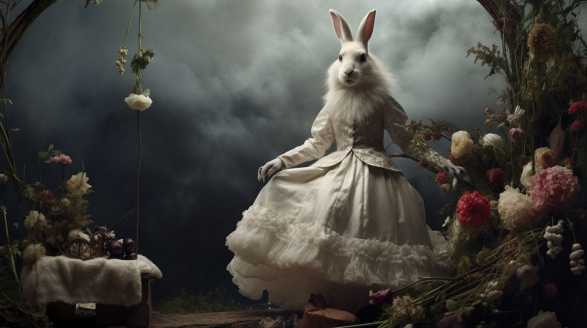
When it comes to ancient civilizations, the Aztecs certainly had a fascinating mythological belief system. From gods and goddesses to elaborate rituals, their culture was steeped in intriguing stories and symbolism.
we will explore the connection between rabbits and fertility in Aztec mythology and unravel the mysteries behind this ancient belief.
The Divine Connection: Ehecatl and the Rabbit
To begin our exploration, we must first look into the myth of Ehecatl, the Aztec god of wind. According to legend, Ehecatl had the ability to transform himself into various animals, one of which was a rabbit.
The Symbol of Fertility
Rabbits have long been associated with fertility in numerous cultures around the world, and the Aztecs were no exception. These adorable creatures are known for their rapid reproduction, with females capable of giving birth to multiple litters each year.
The Sacred Duty of Tepoztecatl
While Ehecatl embodied the divine connection between rabbits and fertility, another deity played a crucial role in this belief system. Tepoztecatl, the Aztec god of pulque, a traditional alcoholic beverage, was also associated with rabbits.
Rituals and Symbolism
In Aztec culture, rituals and symbolism played a vital role in everyday life. Rabbits were often depicted in Aztec artwork and sacrificial offerings, symbolizing fertility and prosperity.
Rabbit as a Representation of the Moon
In addition to their association with fertility, rabbits also held symbolic significance in relation to the moon in Aztec mythology. The Aztecs observed a close connection between the lunar cycle and the fertility of crops and animals.
Rabbits, with their mythical connection to the moon, became a representation of this cyclical pattern, further solidifying their role in Aztec beliefs.
The Rabbit and Xochiquetzal
Xochiquetzal, the Aztec goddess of beauty, love, and fertility, was closely associated with rabbits. She was often depicted with a rabbit by her side, emphasizing the link between fertility and feminine power.
Rabbit Mythology in Modern Mexico
Although Aztec civilization ceased to exist centuries ago, the symbolism and beliefs associated with rabbits have left a lasting impact on Mexican culture. Even today, rabbits continue to be regarded as symbols of fertility and are often included in traditional celebrations and religious ceremonies.
The connection between rabbits and fertility in Aztec mythology reveals the deep reverence the Aztecs held for the natural world and its cycles. The rabbit, with its rapid reproduction and association with deities like Ehecatl and Xochiquetzal, became a powerful symbol of fertility and abundance in Aztec culture.
Today, the legacy of these beliefs continues to thrive, reminding us of the rich and vibrant mythology of the Aztec civilization.
Rabbits in Greek Mythology: From Artemis to the Minotaur
*Have you ever wondered about the role of rabbits in Greek mythology? If you have, then you’re in for an intriguing and captivating journey through ancient tales that feature these furry creatures.
Join me as we explore the enchanting world of rabbits in Greek mythology.*
The Rabbit and Artemis: A Divine Connection
In Greek mythology, Artemis, the goddess of the hunt, has a deep connection with rabbits. These creatures symbolize her affinity for the natural world and her role as the protector of wildlife.
- Swift and nimble: Just like Artemis herself, rabbits are renowned for their speed and agility. They dart through the forest, leaping effortlessly over obstacles, mirroring the goddess’s grace and swiftness.
- Fertility and abundance: Rabbits are known for their prolific breeding habits, often seen as symbols of fertility. They are associated with Artemis, who herself is a patroness of childbirth and nurturing.
- Sacred companions: In many myths, Artemis is accompanied by a retinue of animals, and rabbits are often among them. These furry creatures are considered sacred to the goddess, representing her divine presence and protection.
The Moon Rabbit: A Celestial Connection
Ancient Greek mythology also features a celestial link between rabbits and the moon. This connection can be traced back to the story of Artemis and her twin brother, Apollo, and their ties to the lunar realm.
- Moonlit silhouettes: The image of a rabbit imprinted on the moon’s surface, known as the “Moon Rabbit,” has captivated various cultures throughout history. In Greek mythology, it is believed that Artemis placed a rabbit on the moon as a reminder of her eternal presence in the celestial realm.
- Rabbit-shaped craters: Observers of the moon’s surface have spotted craters that resemble the outline of a rabbit. These lunar features further reinforce the folklore surrounding the Moon Rabbit and its connection to Artemis.
Rabbits and the Minotaur: Mysterious Encounters
The Minotaur, a fearsome creature with the body of a man and the head of a bull, also intersects with the world of rabbits in Greek mythology. Explore the intriguing details below:
- Labyrinth-dwellers: According to the myth, the Minotaur resided in a labyrinth on the island of Crete. This labyrinth was believed to be constructed by the legendary architect Daedalus. It is said that this intricate maze contained underground warrens where rabbits made their homes.
- Fertility symbolism: The presence of rabbits within the labyrinth adds another layer of symbolism to the myth. Just as the Minotaur is associated with power and chaos, rabbits are seen as symbols of fertility, creating a parallel between the two.
- Contrasting symbolism: The association of rabbits with the Minotaur also showcases the duality present in Greek mythology. While rabbits represent life and abundance, the Minotaur represents darkness and savagery. This stark contrast heightens the intrigue surrounding these mythical creatures.
As we look into the world of rabbits in Greek mythology, we uncover a tapestry of symbolism, connections, and intriguing tales. From their divine association with Artemis to their encounters with the enigmatic Minotaur, rabbits leave an indelible mark on the mythological landscape.
Whether they embody swiftness and fertility alongside the goddess of the hunt or inhabit the underground warrens of a labyrinth, rabbits captivate our imagination and invite us to delve deeper into the mysteries of Greek mythology.
So the next time you spot a rabbit hopping through a field or gaze up at the moon, remember the hidden tales that connect these marvels of nature to the ancient myths of Greece.
The Sacred White Rabbit in Celtic Mythology
A Mythological Creature That Captivates the Imagination
The Ancient Celts and their Fascination with Animals
As a lover of mythology, I have always been intrigued by the captivating stories and creatures that populate ancient folklore. One such enigmatic being that has always captured my imagination is the Sacred White Rabbit in Celtic mythology.
Join me in unraveling the mysteries surrounding this intriguing creature!
The Symbolism of the White Rabbit
A Messenger of the Otherworld
In Celtic mythology, the White Rabbit is often associated with the divine and considered a messenger from the Otherworld. It is believed to possess magical abilities that grant it the power to traverse between realms.
Fertility and Rebirth
The White Rabbit’s association with fertility stems from its reputation as a prodigious breeder. Just like the cycles of nature, the rabbit’s constant procreation symbolizes fertility and the continuous cycle of life.
Tales of the White Rabbit in Celtic Mythology
The Mysterious Pooka
One of the most famous stories involving the Sacred White Rabbit in Celtic folklore is the tale of the Pooka. This mischievous creature, often depicted as a giant rabbit, roams the Irish countryside playing tricks on unsuspecting individuals.
The White Hare of Mabinogion
The Mabinogion, a collection of Welsh legends, also mentions the presence of the Sacred White Rabbit. In the tale of Pwyll, Prince of Dyfed, the protagonist encounters a beautiful white hare while out hunting.
The Moon and the Rabbit
In Celtic mythology, the moon holds great significance, symbolizing femininity, intuition, and the mystical. The White Rabbit is often associated with the moon, further enhancing its connection to the Otherworld and the divine.
The Influence of the Sacred White Rabbit
Celebrations and Festivals
The intriguing lore surrounding the Sacred White Rabbit has had a profound impact on Celtic celebrations and festivals. One such example is the festival of Beltane, a significant holiday marking the beginning of summer.
Art and Symbolism
The image of the Sacred White Rabbit has become a popular motif in Celtic art and symbolism. Intricate carvings, jewelry, and tapestries often depict the rabbit alongside other mythological creatures, serving as a reminder of the intertwined relationships between the earthly and the divine.
Modern Interpretations
Even in modern times, the allure of the Sacred White Rabbit continues to captivate and inspire. It often makes appearances in literature, art, and popular culture, symbolizing mystery, magic, and the pursuit of spiritual enlightenment.
Opening the Door to the Unknown
The Sacred White Rabbit in Celtic mythology holds a special place in the hearts and minds of those who appreciate the mystical nature of ancient folklore. Its symbolism of fertility, rebirth, and connection to the Otherworld resonates with our collective human longing for the unknown and the spiritual realm.
The Rabbit’s Foot: Talismanic Beliefs and Superstitions
Hey there, curious reader! Have you ever wondered why some people carry around a small fuzzy charm on their keychain?
Prepare to have your mind blown as we embark on a journey through history, cultures, and the weird and wonderful world of lucky charms.
What’s the Deal with Rabbits’ Feet?
Let’s start by unraveling the mystery behind rabbits’ feet as talismans. It seems strange, right?
Well, the origins of this superstition are as diverse as the cultures that uphold them.
Origins and Cultural Significance
Believe it or not, the belief in lucky rabbit’s feet can be traced back centuries. Ancient Celtic tribes revered rabbits as sacred animals, associating them with good fortune and fertility.
An Unlucky Bunny
Hold your horses! Before you start hopping around searching for a rabbit’s foot for your keychain, you should know that not all rabbits’ feet are believed to be lucky.
Talk about specific!
Rabbit’s Foot: The Ultimate Good Luck Charm?
So, what makes a rabbit’s foot a talisman of good fortune? Well, let’s dive into the world of rabbit-related superstitions:
1. Speedy Delivery
Ancient civilizations believed that carrying a rabbit’s foot would bring fertility, ensuring a speedy pregnancy and a safe delivery. So, if you’re planning to start a family, this may be the charm for you!
2. Money, Money, Money!
Money, money, money, it’s a rich man’s world! According to some superstitious folks, carrying a rabbit’s foot can attract wealth and prosperity.
3. Protection Against Evil Spirits
In some cultures, superstitions suggest that a rabbit’s foot possesses the power to protect its owner from evil spirits and hexes. It’s like carrying a portable guardian angel in your pocket!
4. Lucky in Love
Looking for love? Maybe that cute little rabbit’s foot could be your secret weapon!
Are You a Believer?
Now, let me ask you, dear reader: do you believe in the mystical powers of the rabbit’s foot? Some swear by it, while others dismiss it as nothing more than a quirky superstition.
Rabbit’s Foot: Fact or Fiction?
While we can’t scientifically prove the magical properties of a rabbit’s foot, we can certainly explore its symbolism and significance throughout history. Countless tales and anecdotes of rabbit’s foot encounters continue to captivate our imaginations to this day.
Do Rabbit’s Feet Have a Dark Side?
As we delve deeper into the rabbit hole of superstitions, it’s important to note that not all cultures view rabbits’ feet through rose-tinted glasses. Some believe that taking a rabbit’s foot without permission may bring upon bad luck or even curse the thief.
The Power of Belief
At the end of the day, the mystical properties of the rabbit’s foot are deeply rooted in the power of belief. Whether you’re a skeptic or a die-hard believer, there’s no denying the impact these talismans have had on cultural practices worldwide.
So, What’s Your Lucky Charm?
Now that you’ve been enlightened about the rabbit’s foot, it’s time to contemplate your own lucky charm. Perhaps you’ll stick with the rabbit’s foot, or maybe you’ll explore other superstitions and talismans from different cultures.
Penny for Your Thoughts?
Before we part ways, I’d love to hear your thoughts on this whimsical topic. Do you own a rabbit’s foot?
Share your experiences and superstitions in the comments below. Who knows?
Until then, may you find luck in the most unexpected places, my friend!
The rabbit’s foot has certainly left its mark on cultures around the world, from ancient times to the present day. Whether you see it as a symbol of luck, protection, or just a quirky curiosity, one thing is for sure – the rabbit’s foot has woven itself into the tapestry of our collective belief systems.
Conclusion
Phew! What a whirlwind adventure we’ve been on, exploring the world of rabbits in mythology.
And let’s not forget their symbolism of rebirth and fertility in ancient Egypt, China, and Native American cultures.
But what about the mystical connection between hares and the moon? From the Moon Rabbit in Chinese and Japanese folklore to the sacred connection of rabbits and the lunar cycles in Native American tribes, the allure of these celestial creatures is undeniable.
Now, I know some of you are thinking, “Does it really matter? Are lucky charms and superstitions just silly beliefs?” Well, the answer lies in the power of belief itself.
And if carrying a little talisman brings us comfort, hope, or a sense of connection to something greater, then who are we to judge?
So, whether you’re a skeptic or a believer, I invite you to ponder the magic and wonder that rabbits have brought to cultures across time and space. Let their tales and symbolism ignite your imagination and remind you of the power of folklore and mythology to shape our beliefs and perspectives.
As I bid you farewell, I hope this journey has left you with a newfound appreciation for the enchanting world of rabbits in mythology. Whether you choose to carry a lucky charm or simply enjoy the tales that surround these mystical creatures, may you find joy, inspiration, and a touch of wonder in the tales of the hopping heroes that have captured our imaginations for centuries.
As for me, well, I think I might just keep that rabbit’s foot on my keychain. Who knows?
Frequently Asked Questions
1. Are rabbits commonly associated with mythology?
Yes, rabbits are often mentioned in various mythologies from around the world. These creatures hold symbolic significance and feature in numerous folklore tales.
2. Which mythology features a prominent rabbit figure?
The mythology that prominently features a rabbit is the Chinese folklore, where the Moon Goddess Chang’e is accompanied by a rabbit named Jade Rabbit. It is believed that the rabbit resides on the moon and is responsible for making the elixir of immortality.
3. What symbolism is associated with rabbits in mythology?
Rabbits are often associated with fertility, rebirth, and abundance in mythology. They can also symbolize agility, cleverness, and intuition.
4. Is there a famous figure that has a connection to rabbits in mythology?
The famous trickster figure from Native American mythology, Nanabozho or Manabozho, is often depicted in the form of a rabbit or hare. Nanabozho plays mischievous tricks and teaches important lessons to humans.
5. Are there any myths or legends about rabbits and the moon?
Yes, several mythologies associate rabbits with the moon. Apart from the aforementioned Chinese myth, Native American tribes such as the Cheyenne and the Mi’kmaq also have stories that explain the presence of a rabbit on the moon.
6. What is the significance of rabbits in Aztec mythology?
In Aztec mythology, the god Quetzalcoatl is often depicted wearing a rabbit skin as a symbol of fertility and transformation. Rabbits were considered sacred animals associated with rebirth and the cycles of nature.
7. Do rabbits play any role in European folklore?
Yes, rabbits feature in European folklore as well. They are often portrayed as magical creatures and are sometimes associated with witches and fairies. In some tales, rabbits are said to possess special powers or serve as guides in enchanted forests.
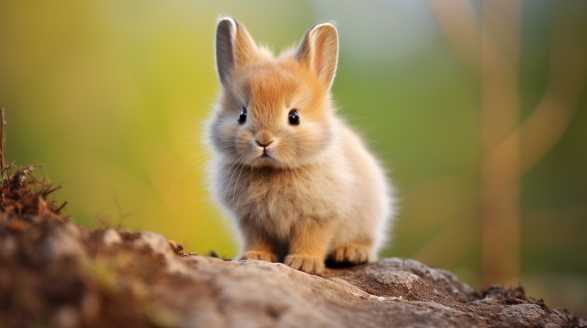
Why Are Rabbits So Cute
Introduction Get ready to dive into the enchanting world of one of the cutest creatures on the planet: rabbits! From their soft fur and twitching noses to their irresistible charm, these adorable animals never fail to capture our hearts. We’ll start by taking a closer look at the anatomy of these fluffy friends. Their soft […]
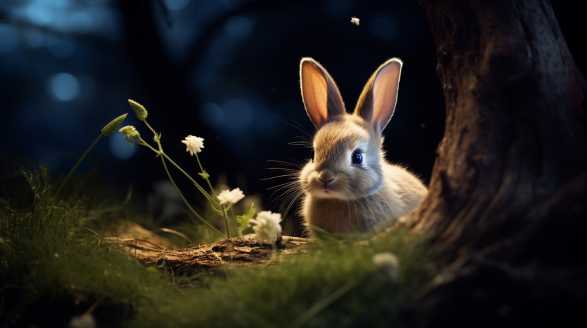
Are Rabbits Nocturnal
Introduction Are rabbits nocturnal? Let’s find out. With its fluffy tail and twitching nose, the rabbit has become the star of my wildlife exploration. But what truly fascinates me is their nocturnal behavior. Imagine venturing into the depths of night to witness their hidden world come to life. It’s like finding a secret portal to […]
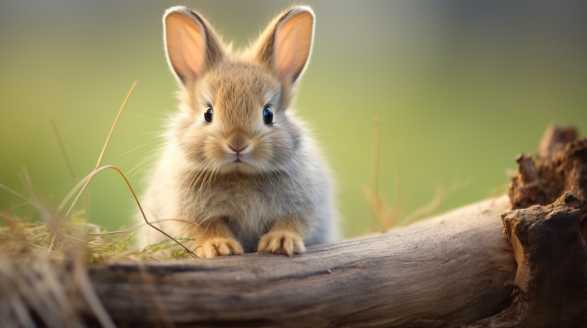
Do Rabbits Purr
Introduction Do rabbits purr? Let’s find out. Imagine this: you’re sitting in your cozy living room, cuddling with your beloved pet bunny. As you stroke its soft fur, you hear a low, rhythmic hum. Your eyes widen with curiosity as you wonder, “What does this purring mean? Is my bunny happy? Amazed by my petting […]
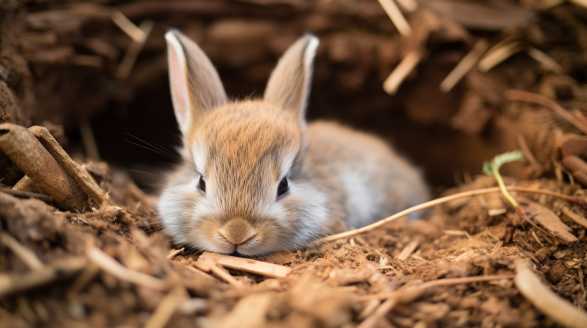
Is Aspen Bedding Safe For Rabbits
Introduction Hey there rabbit owners! Are you looking for the safest and most comfortable bedding option for your fluffy friend? we’ll be diving into the topic of aspen bedding for rabbits and exploring its safety and benefits. As a passionate rabbit owner myself, I understand the importance of choosing the right bedding material for our […]
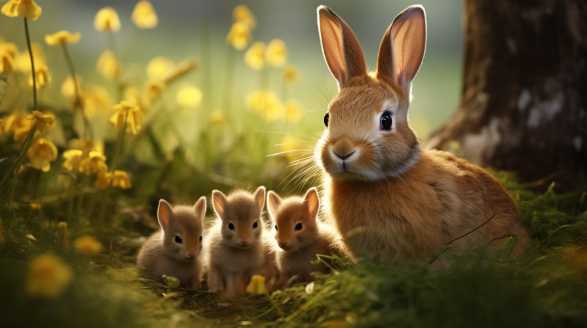
When To Wean Rabbits
Introduction Are you ready to embark on the journey of transitioning your baby to solid food? Well, you’re in the right place! I understand that this can be a confusing and slightly overwhelming phase, but fear not! I’m here to guide you every step of the way. As a parent, one of the most thrilling […]
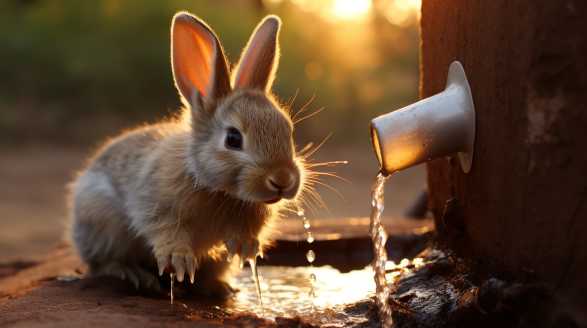
What Do Rabbits Drink
Introduction Are you a rabbit owner looking to make sure your furry friend is getting the best care possible? You’re in the right place! You might already know that rabbits need a balanced diet to stay healthy, but did you know that water is a crucial part of that equation? It’s true! But how much […]
